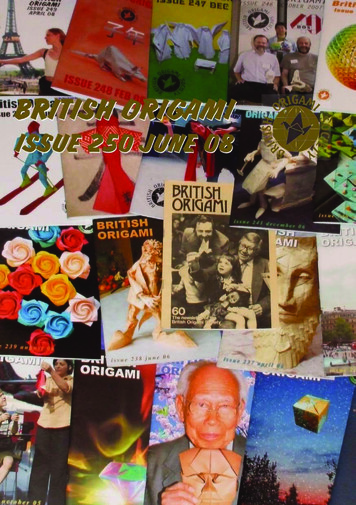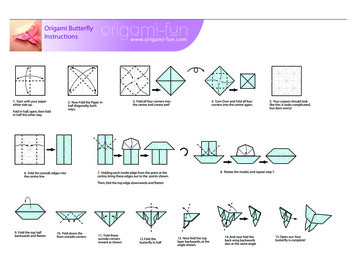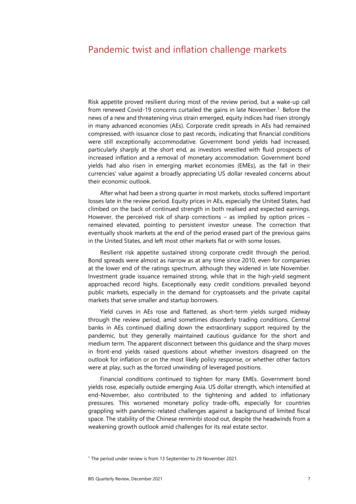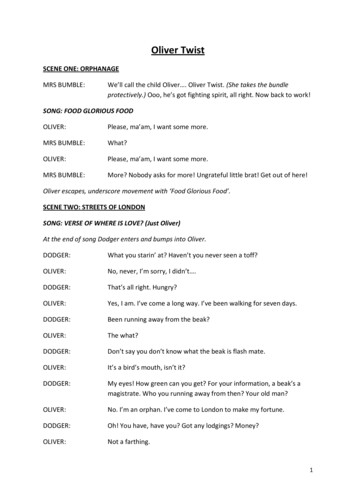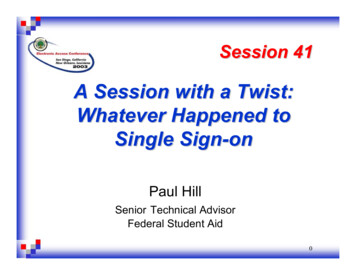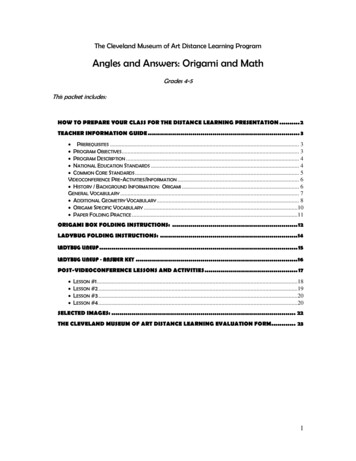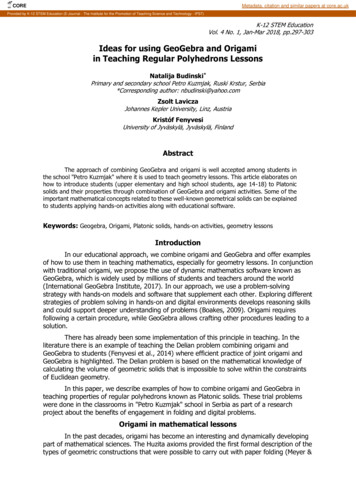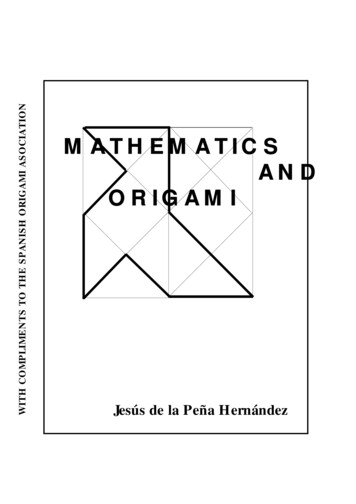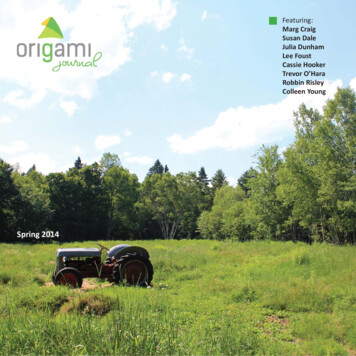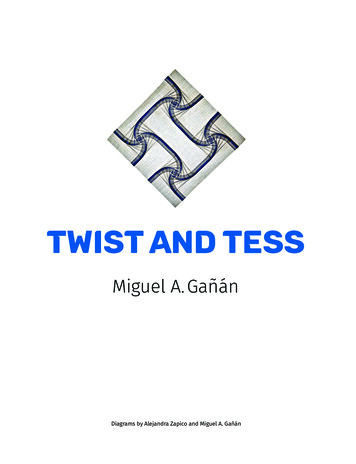
Transcription
TWIST AND TESSMiguel A. GañánDiagrams by Alejandra Zapico and Miguel A. Gañán
Copyright 2020 Miguel A. GañánAll rights reserved. No part of this publication may be reproduced, stored in orintroduced into a retrieval system, or transmitted in any form or by any means(electronic, mechanical, photocopying, recording or otherwise), without the priorwritten permission of the copyright owner. The infringement of such rights mayconstitute an offence against intellectual property.However, for non-commercial teaching purposes of these models, the book buyercan teach any of the models without the need to ask for specific permission.For more information:Facebook: Miguel GañanFlickr: mganansIG: tesegami origamiMail: mganan es@yahoo.comCover and back cover photo: composition of models designed by the author.Cover design: editopia.com.arInterior design: Verónica CarmanEnglish translation: Sol Gañán YoshiharaISBN: 9780578774312
Dedicated to my wife, Gabriela and our daughter Sol,for their unconditional support from my beginnings in the worldof origami, their help and encouragement in preparing thisbook, and for allowing me to transform our home into a smallmuseum for origami.And a very special thanks to the rest of my family in Spainand Argentine, for admiring my models and being the first onesto encourage me to create new designs.
たい。Tomoko FuseMiguel Gañan’s works have the beauty of precision.If you observe the beautiful photographs in this book, you will seeit clearly.With simple and detailed explanations, the book shows theauthor’s personality and his desire to share the beauty and all theinteresting aspects of the art of Tessellation.For those who wish to start dabbling in this art, this material willbe of great use.I would like to acquire it right now and gift it to all my friends whohave an interest in said art.Tomoko FuseTWIST AND TESS l 7
ACKNOWLEDGEMENTSTOMOKO FUSE: my “sensei” in the distance, whom I had thepleasure of meeting in person at the Origami Argentina conventionin 2016. Her “Triangular equilateral unit” was a discovery forme, and it allowed me to create my first original designs. Herwonderful books have always been a big source of inspiration formy works.ALEJANDRA ZAPICO: without her help, drawing most of thediagrams by hand, this book would not have been possible. Hercommentary “if I don’t understand how to fold a model, I can’tdraw it” pushed me towards working harder to simplify the foldingof the models.VERONICA CARMAN: with her design of the book, she has managedto depict in an incredible way all my ideas and suggestions as acreator, to put my first creation in your hands.SOL GAÑAN YOSHIHARA: our daughter, that accepted my proposalto be the translator. With a little help from myself with specialorigami terms, and some technical adjustments, I am really proudof the result of her translation.LAURA ROZENBERG: her support in the diffusion of my folds(with my participation in her Origami museum in Coloniadel Sacramento, Uruguay), and her immeasurable help andencouragement during my first steps in the creation of this book.LAURA AZCOAGA: the one who introduced me to the world ofmodular origami. First, her website and her folds with “sonobes”,and then her “snapology” workshop, made me enter that infiniteworld of the modulars.ORIGAMI ARGENTINA, with all its members and friends, who havealways followed my creative process, encouraging me to writethe book.ERIC GJERDE: with his book “Origami Tessellations”, he turnedtessellations into a “good drug” for me. Thanks to him, my interestfor tessellations grew little by little and allowed me to startcreating my own designs.TWIST AND TESS l 9
Flickr group “Origami Tessellations”: for their unconditionalsupport during my first models and their “favourites”, whichencouraged me to create new ones and dig deeper into the learningof new models. Amongst them, Robin Scholz, Marjan Smeijsters andMichal Kolsmuslki.Argentine Japanese cultural foundation: for allowing me tomake myself known with my first exhibitions, both with my ownmodels and from other authors which I folded when I started.NICHIA GAKKUIN: with their fair Nipponmania, which has allowedme to show my new designs every year.Edgardo Marchessi: with his art fair “Expoartistas”, he helpedme enter the art world, and include origami in that environment.Alejo Wilkinson and Jimena Candia: trying the diagramsto improve the folding process.Yoshiko Yone: for her help in the translation of TomokoFuse’s prologue.Miguel A. GañánTo Miguel Gañán, for giving me this opportunity and trust in mywork, for letting me in on the wonderful world of tessellations withhis accelerated workshop”.To Alejo Wilkinson, friend, partner and “sidekick”, for believing in meand for his endless patience while testing my drawings.To my origami sisters Maria Eugenia “la Reina Sandin” and Gaby“Ormiga” Orso for encouraging me in this adventure and remaininginterested on the advance of my work.To my family, Ruben, Lula, Vero, Sere and Wayra (my dog, faithful earlymorning companion) for letting me steal hours of their time(a lot !!) and dedicate it to diagramming, folding and back to drawing.And lastly, because he is the most important, Leandro Carlos PoloMadueño, Master of Masters, my dearest friend, for teaching me howto diagram, for waking up my love for drawing and trust that I wouldfollow this path; for having a lot of patience and being a faithfuland critical tester of my drawings so that today my contribution tothis book is a reality. Seated on a cloud, I know he must be happy.Alejandra Zapico10 l TWIST AND TESS
CONTENT14INTRODUCTIONWHY A BOOK ABOUT TESSELLATIONS?17HOW TO USE THE BOOK18WHAT IS A TESSELLATION19TESSELLATIONS AND ORIGAMI (A LITTLE BIT OF HISTORY)20A BIT OF MATHEMATICS2022BASIC TECHNIQUES25MATERIALS25 PAPERS27 NECESSARY TOOLSHOW TO FOLD A TESSELLATION29CP INTERPRETATION2930PREPARING THE GRID30ADD THE PLEATS OUTSIDE THE GRID (PRE-CREASE)30COLLAPSE THE MODEL31GRIDS31BASIC CONCEPTSGRID SECUENCES3132 SQUARE GRIDSTRIANGULAR GRIDS (IN HEXAGONAL PAPER)32TRIANGULAR GRIDS (IN SQUARE PAPER)34REAL DIMENSIONS (IN 35X35 CM PAPER)363737TWISTS AND PLEATS120 DEGREE PLEAT INTERSECTIONTWIST AND TESS l 11
38TESSELLATIONS41TESSELLATIONS WITH TRIANGULAR TWISTS41CLOSED TRIANGLE TWIST42OPEN BACK TRIANGLE TWIST42DOUBLE SIZED CLOSED TRIANGLE TWIST43MAGIC RING49SMALL DANCING COUPLES55BIG DANCING COUPLES61HEXAGONS AND TRIANGLES65ONE RING TO RULE THEM ALL71SPIDERWEB77SNOWFLAKESBOUQUET8389TESSELLATIONS WITH RHOMBIC TWISTS89RHOMBIC TWIST90RHOMBIC TWIST (VARIATION)91RHOMBIC TWIST WITH ARMS93RHOMBIC TWISTS GALAXY99TRIANGLE RINGRHOMBIC FLOWERS105109BRACELET115 TESSELLATIONS WITH RHOMBIC, TRIANGULAR AND HEXAGONAL TWISTS115CLOSED HEXAGONAL TWIST (TWISTING)116CLOSED HEXAGONAL TWIST (PLEATING)116OPEN BACK HEXAGONAL TWIST117DIAMOND CROWN I123SWIRL129DIAMOND CROWN III135RHOMBUS WHEELS139 TESSELLATIONS WITH OTHER TWISTS139PARALLELOGRAM TWIST140TRAPEZOIDAL TWIST140TEARDROP TWIST12 l TWIST AND TESS
141145149155159165MASK PARADETRAPEZOIDAL TWISTPETALSTRAPEZOIDAL TWIST IDAFFODILFLYING ATOMS171 TESSELLATIONS WITH STACKED TWISTS171SQUARE TWIST (WITH FORCED TWIST)172SQUARE TWIST (WITH PLEAT)173 HANOI TOWER177PYRAMID FIELD183MALLOS DE RIGLOS187TILED PYRAMIDS192 BOXES195FOLDING SEQUENCE197BOTTOM BOX199RHOMBIC TWISTS FLOWER I203RHOMBIC TWISTS FLOWER II207TILED PYRAMIDS210 OMIYAGE213OMIYAGE (TATO)215SIX TRIANGULAR TWISTS219TILED PYRAMIDS222 APPENDICES224 BASIC VOCABULARY ENGLISH-SPANISH225 SYMBOLS USED IN THE BOOK226 REFERENCES226MY FAVOURITE CREATORS226ORIGAMI BOOKS227 OTHER REFERENCES227 CREDITS (PHOTOGRAPHS)228 AUTHOR’S DATATWIST AND TESS l 13
NOITCUDORTINTWIST AND TESS l 15
INTRODUCTIONl.s and triangles” modeonSeveral steps, “Hexag16 l TWIST AND TESS
LET S GET THE PAPERWhy a book about tessellations?When I first got my hands on Eric Gjerde’s book in October 2011, anew world of possibilities opened up for me in origami.My beginnings, back in 2007, had been with modular origami andthen with “snapology”; always origami related to mathematics(and with my background as an aeronautical engineer).With Gjerde’s book, and then Shuzo Fujimoto with his “hydrangea”,my first tessellations couldn’t have had better masters.And so that’s how I entered this wonderful world of thetessellation, with the first model “Five and four”. After graduallyfolding the rest of the models and uploading my first photosto Flickr in the “Origami tessellations” group, I met an amazinggroup of origamists related to tessellations (Robin Scholz andLydia Diard were who initially caught my attention, and theyserved as teachers with their models and advice).My first Eric Gjerde tessellationThe tessellations virus entered my veins and has yet to come out At the end of 2017, I can’t remember the exact moment, whileI was playing with a square grid and twist, my first design, “TheHanoi tower” appeared in my hands. That was the breakingpoint, the “click” that made me realise I could create my owntessellation models.Little by little, the rest of the models started appearing, and aftershowing them to the Buenos Aires origami group and then at theOrigami Argentina conventions, a lot of people asked me to giveworkshops.My first Shuzo Fujimoto tessellationIn 2018, going over the bibliography related to tessellations,the few existing books were only in English. After talking withsome of my origamist friends, and a talk with Laura Rozenberg,I decided that the best way of passing on my knowledge was bypreparing a book (which would be the first one in Spanish) withsome of my original designs. This english edition is the literaltranslation of the spanish one.TWIST AND TESS l 17
INTRODUCTIONAnd so, I got to work. My idea was to create a book withdiagrams (not photographs) with the folding instructions.I contacted several origamists that did diagrams, until I foundsomeone from our group. She had never done tessellationsbefore, but, when presented with the challenge of drawingtessellation diagrams, accepted without hesitation.At first, the idea was to publish Alejandra’s drawings directly,but when we saw that the time to finish the book would be toolong, we decided to transfer these drawings to Inkscape,to avoid having to redraw the clean diagrams by hand.It’s oriented to origamists who want to get started in thetessellation world, who have seen models folded with thistechnique, and who feel curiosity to know how to start andeverything related to this technique.Arabic MosaicsHow to use the bookStarting with a brief introduction to tessellations (from theirorigin in ancient times) and their relation with mathematics,it includes basic information about the knowledge required tostart folding tessellations, recommended materials and advicebased on my own experience.Cathedral “Vitreaux”Roman Mosaic18 l TWIST AND TESS
After explaining how to prepare the grids in detail, the necessarytechniques for folding (twists and pleats) are described, beforemoving on to the models, all of them my original designs.The models are classified in accordance to the type of twistsused in them, starting with the triangular twists, followed by therhombic and hexagonal, and ending with some uncommon ones(parallelograms, trapezes, teardrops).And as last models, those that use stacked twists (they are partof my analysis’ published in OrigamiUSA).Lastly, there are two additional chapters, related to the sametessellations technique, but with a different final result:llBoxes with tessellations in their lid.Omiyage (Tato) with tessellations that appear when opened.In all the models, the basic molecule is shown with anexplanation on how to fold it and how to unite/connect it toothers in order to create the final tessellation. The CP with anormal grid is also included (32 or 48 divisions). In those casesin which the model can be extended and its CP is different fromthe original, said CP is shown.Included at the end:A small English-Spanish dictionary with the usual termsused in tessellations.l A table with the symbols used in the book.l References to other authors, books and websites.lWhat is a tessellation?Many of you may have seen tessellations in your daily life, notknowing that they are. If we go back to ancient times, we canobserve tessellations in the Roman age constructions.The origin of the word tessellation goes back to the Romanage. The “teselas” are the small square rocks that were used tocreate those tiles or mosaics we see in floors and walls.Shuzo Fujimoto s tessellationsLater, in the Arab era and especially in Spain, in the mosques,we can see wonderful examples of tessellations created byArab artisans.TWIST AND TESS l 19
INTRODUCTIONWe can also find them in the stained-glass windows of cathedrals.In the contemporary age, some artists (mainly painters) have alsomade use of the tessellations in their wok (M.C. Escher for example).Tessellations and origami (a little bit of history)Entering our world of origami, in the 70’s of the last century, agreat Japanese origamist, Shuzo Fujimoto, published the firstbooks that made use of those designs.Tessellation 3.3.3.3.3.3Closer to us, Ron Resch, Chris Palmer, Robert Lang, Eric Gjerde andEric Joisel have been a few of the origami artists that have heavilyinfluenced the development of this technique.In origami, what we call tessellations are the geometric designsfolded from a single paper, repeating patterns around the paper,(in the book we will call them molecules) by twists and pleats.They can range from simple models, with very few twists and pleatsto complex models such as Eric Joisel’s three-dimensional masks.A bit of mathematicsTessellation 4.4.4.4For those interested in the connection between tessellations andmathematics, we will go over some basic concepts th
pleasure of meeting in person at the Origami Argentina convention in 2016. Her “Triangular equilateral unit” was a discovery for me, and it allowed me to create my first original designs. Her wonderful books have always been a big source of inspiration for my works. ALEJANDRA ZAPICO: without her help, drawing most of the diagrams by hand, this book would not have been possible. Her .
